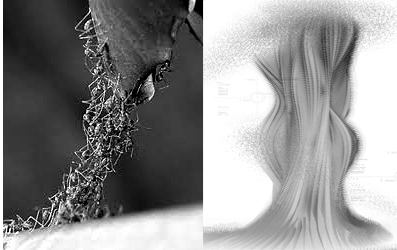A critical analysis of the book Swarm Intelligence – Neil Leach
As we all know about many examples of swarm logic in nature, they all do, without thinking, always use the most simple way of constructing – because it imposes itself as the most logical one. Because insects like bees don’t rethink their decisions, they don’t have the capacity for that, but they don’t even need it. Fish don’t really think about the way they are forming groups, it’s a part of their genetic code. Because the nature creates simple rules, which when followed, without exceptions, always work in the best interest of the community.
On the other hand if we observe a correlation between a man and his neighborhood or a city and comparing it to an ant colony for example we can see huge number of differences. But the one thing is impossible to oversee, that the city same as an ant colony works using the same system of “reading” the response information from the single agents. Because on the end we realize that in both cases the solution to development , constancy and stability of the whole system is reciprocal interaction.
A city grows in a same way that its parts are developing, although his agents (in this case residents of the city or a neighborhood) are unaware of this fact, with every action they are contributing this commune intelligence. Taking an example of a micro scale of a human body- what one cell does doesn’t really make a difference, but set of cells, organs and on the end the entire organism are capable of making truly complex decisions on various levels.
If we go back to the response information that we are getting from each agent as an individual, in micro scale, inputs are something we should be focused on. My interpretation of this book is that we should be more concentrated on designing interactive systems rather than separate units. Because the system is something that is interactive, the system can develop and response to the needs of its inhabitants. All the answers about creating such a system are right there, in front of us. Ours is just to recognize them and implement the same simple rules, using the today’s tools of visualization and computational techniques to test it and to find the best solutions of implementing it in the new architectural systems of tomorrow.

